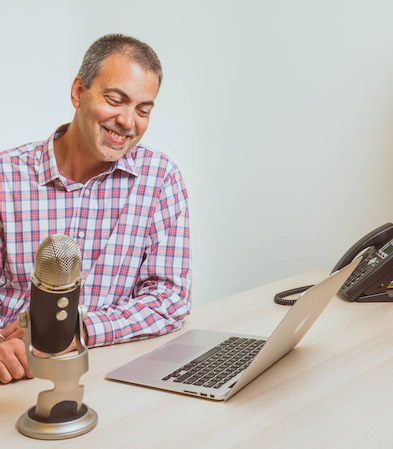
Share this Post
Subscribe

Need help with your money or investments? Book a consultation to learn more about working together.
How to Navigate Market Volatility Without Losing Your Cool
[Prefer to listen? You can find a podcast version of this article here: E276: How to Navigate Market Volatility Without Losing Your Cool]
Volatility is a natural part of investing. It’s the “price of admission” that we pay in exchange for the opportunity to grow wealth over time.
But when markets start swinging wildly, especially to the downside, it’s easy to let emotion take the wheel.
Why does volatility happen, what does it mean for long-term investors, and how can you position yourself to stay confident and grounded through market ups and downs?
What Is Market Volatility?
Volatility refers to the big moves, both up and down, that we see in the market. It’s the reason we get headlines like “Stocks Plunge Amid Global Uncertainty” one day, and “Markets Rally on Economic Optimism” the next.
Investors tend to enjoy the ride on the way up. But when the market drops, fear often takes over.
Many investors start to ask: What should I do when the market gets rocky?
It starts with understanding volatility and building your plan around it.
Why Does the Market Swing So Much?
Markets are information-processing machines. When new data (like changes in interest rates, geopolitical developments, or corporate earnings) enters the system, prices adjust to reflect it.
This adjustment happens constantly. Sometimes it’s subtle. Other times, it's dramatic.
For example, during a period of heightened uncertainty in early 2025, the market dropped nearly 5% in a day, followed by another 6% drop the next day. But then, only days later, it rebounded more than 9%.
These swings weren’t random. They were the result of investors absorbing and reacting to new information, including policy shifts and economic outlooks.
High trading volumes during those times further confirm that markets were actively processing new realities.
It’s not chaos. It’s how the market works.
The Emotional Cost of Volatility
Seeing your portfolio drop sharply over a few days is never a comfortable experience. And if you're not prepared, it's easy to make emotional decisions that derail long-term plans.
This is where perspective helps.
On average, the S&P 500 sees about three “pullbacks” (or drops in value) per year.
However, the S&P 500 has produced positive calendar year returns approximately 75% of the time since 1926.
That history reinforces a simple but powerful point: markets go up and down, but over time, they tend to go up more often.
If you let your emotions take over and focus on the short-term drops in the market by selling off your investments, you run the risk of missing the gains that often follow.
Missing the Rebound Can Hurt
The real risk of selling during a downturn isn't just locking in losses. It’s missing the recovery.
Take the beginning of 2025 as an example. At the end of April, the year-to-date return for the S&P 500 was negative by over 5%. Just one month later, it was up approximately 1% year to date. Three months later, it was up over 8% YTD. And by the end of August, the S&P 500 was up over 10% year to date.
Investors who exited the market in fear would have missed that recovery.
This kind of rebound isn't unusual. Historically, many of the best days in the market happen close to the worst ones.
Selling off at the wrong time can significantly damage your long-term returns.
Expect the Unexpected
One of the most useful mindsets for investors is to expect the unexpected.
No year in the market is “normal.” There’s always something happening: economic data, policy changes, geopolitical events. And often, those developments create turbulence.
But just because the headlines are noisy doesn’t mean your financial plan needs to be.
A great example is 2023. Despite a year filled with financial and political concerns, the S&P returned over 25%.
It’s a reminder that the market often performs better than the news cycle suggests.
Know Yourself as an Investor
The right asset allocation is the one you can stick with. It’s not about chasing the highest return. It’s about aligning your investments with your risk tolerance and goals.
For some, that might mean holding more equities and riding out the volatility. For others, it could mean a more conservative allocation with fixed income or even cash-like assets. The key is to understand your emotional threshold and plan accordingly.
An investor who can't sleep at night during downturns might be better off with less exposure to stocks, even if it means giving up some potential upside. Peace of mind has value, too.
Preparation Beats Reaction
The best time to plan for volatility is before it hits. That means:
- Setting realistic expectations about market behavior.
- Choosing an asset allocation that matches your comfort level.
- Committing to your plan even when the ride gets rough.
Much like an explorer preparing for a long journey, having the right mindset, tools, and preparation makes all the difference when facing uncertainty.
When Do You Plan to Use the Money?
One of the most useful frameworks you can set for yourself is to ask the question, "When do I plan to use this money?"
This question alone can determine a lot of your investment strategy.
JPMorgan publishes an annual guide to the markets that contains, among other things, a useful perspective on how the market behaves over different time periods.
In this guide, we find the following statistics about the S&P 500 from the year 1950 to 2024:
- In any given one-year time period, returns have been as high as 52% and as low as -37%.
- In any given five-year period, returns have been as high as 29% and as low as -2%.
- In any given ten-year period, returns have been as high as 20% and as low as -1%.
- In any given 20-year period, returns have been as high as 18% and as low as 6%.
As you can see, your chances of a positive return dramatically improve with time, and your chances for a negative return decrease substantially as well.
In any given 20-year time period, the market has always seen a positive return.
So if you're investing money that is not designed to be used for 20 years or more, this should give you confidence.
Stick to the Plan
Volatility isn’t a sign that something is broken. It’s a sign that the market is doing its job: responding to change.
It can be uncomfortable. But it’s also what creates opportunity.
When we stay the course through turbulence, we give ourselves a chance to benefit from the market’s long-term growth.
Because over time, despite the bumps along the way, markets have tended to reward patience.

